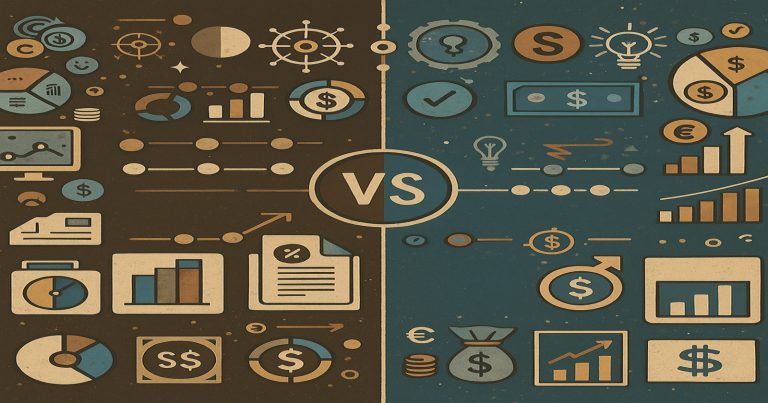A business’s finance fundamentally distinguishes revenue from profit, as they comprise completely different facets of a company’s financial health. Revenue is income from the company’s operations, while profit remains after subtracting all expenses from revenue. An enormous distinction between profit and revenue greatly matters in assessing the business performance, sustainability, and growth potential. In this article, definitions of revenue and profit are given, their effects considered, and the distinctions made.
What is the Difference Between Revenue and Profit?
The difference between revenue and profit is one of the most essential concepts in accounting and financial management. Though closely linked, these two terms represent very different economic realities for a business.
- Revenue is the total amount of money a company earns by selling goods and services. It is also known as sales, turnover, or top-line income.
- Profit is the net income remaining after deducting all costs from revenue, such as production expenses, operating costs, interest, and taxes. It is often called the bottom line.
Revenue vs. Profit
A business needs revenue to survive, but profit determines long-term success and sustainability. Investors and stakeholders often look more closely at profit than just revenue, because profits reflect how well the company performs. Revenue generation is vital in business growth, while profitability is essential for the orderly and sustainable development of the business.
| Aspect | Revenue | Profit |
| Definition | Total income generated from core business operations | Income left after deducting all expenses from revenue |
| Also Known As | Top-line, Sales, Turnover | Bottom line, Net Income |
| Calculation | Price × Quantity Sold | Revenue – (COGS + Expenses + Taxes + Interest) |
| Types | Operating Revenue and Non-operating Revenue | Gross Profit, Operating Profit (EBIT), and Net Profit |
| Position in Financial Report | First line in the Income Statement | Last line in the Income Statement |
| Indicates | The company’s ability to generate sales or income | The company’s ability to manage costs and create earnings |
| Objective | To maximize the total sales volume and reach more customers | To increase efficiency and retain earnings after all obligations |
| Impact of Costs | Not affected by internal costs or external expenses | Highly affected—cost control increases profit even if revenue is constant |
| Significance | Suitable for measuring business size and market penetration | Crucial for assessing financial health, stability, and growth potential |
| Examples | ₹1 crore from selling mobile phones | ₹15 lakhs profit after deducting the cost of goods, marketing, salaries, etc. |
| Revenue Can Be High But | The business may still incur a loss if expenses exceed revenue | A company can be profitable even with modest revenue if it controls costs well |
What Is Revenue?
Revenue refers to the total income a company generates from its core operations, including the sale of goods, services, or other business activities. Often called “sales” or the “top line,” revenue is the first figure in the income statement and does not account for any costs or expenses. It represents the total monetary value of a business’s transactions within a specific period.
Types of Revenue
Revenue gives us a partial view of the success of a company in selling. But it doesn’t say that the company is making profits, as such a figure has not deducted related expenses. It is thus very important to differentiate revenue from profit.
- Operating Revenue: Generated from primary business activities such as product sales, service fees, or subscriptions. Example: A bakery’s revenue from selling cakes is operating revenue.
- Non-Operating Revenue: Income from secondary sources, such as interest income, dividends, or the sale of assets. Though not directly tied to core operations, it contributes to total revenue.
What Impacts Revenue?
Revenue is affected by numerous internal and external factors. These influences are bound to change with market trends, the company’s own strategy, and behavioural changes that may manifest among consumers. Such an understanding would serve companies better in their endeavour to maximise profits.
- Pricing Strategy: Price affects how much income is earned per unit sold. An innovative pricing model can either improve volume or unit profitability.
- Market Demand: Simply put, demand for a product or service is affected by consumer requirements, seasonality, and market circumstances.
- Marketing and Promotion: Campaigns and advertising strategies can directly affect sales performance and revenue growth.
- Product Quality and Innovation: Usually, quality attracts customers, and quality products can afford a premium price, thus enjoying a higher revenue.
- Competitive Landscape: In competitive markets, pricing or promotional adjustments may be necessary to maintain revenue levels.
All of these help shape the top line of the business, which is distinct from what the company retains in profit. That’s where the difference between profit and revenue becomes clearer.
What Is Profit?
Profit is a company’s financial gain after subtracting all costs, expenses, and taxes from its total revenue. Referred to as the “bottom line,” profit is the core indicator of how effectively a business manages its operations and controls costs. Knowing the difference between profit and revenue is essential to evaluate whether the company is not just selling, but succeeding.
Types of Profit
Look at any of these profitability metrics to assess various grades of business profit. It is also critical to distinguish between capital profit and revenue profit for a more detailed financial analysis:
- Gross Profit: Revenue minus the direct costs of goods sold (COGS). It shows the efficiency of core operations without overhead costs.
- Operating Profit (EBIT): Gross profit minus operating expenses like salaries, rent, and utilities. It reflects operational efficiency.
- Net Profit: The final income after all costs, including interest and taxes, are deducted. This is the actual return available to shareholders.
| Type | Description |
| Capital Profit | Earned from non-recurring sources like the sale of assets |
| Revenue Profit | Generated from routine business operations and sales |
What Impacts Profit?
Many factors that reduce costs or improve operational efficiency influence profit. While growing revenue helps, managing expenses is equally important to ensure higher profit margins.
- Cost of Goods Sold (COGS): Direct costs such as materials and labour impact gross profit. Lowering COGS increases margins.
- Operating Expenses: Overheads such as rents, marketing, and administration costs are critical detractors from resources. Keeping it optimised is vital and crucial in boosting operating profits.
- Taxation: Net earnings are taxed. Most companies legally minimise the amounts they owe in taxes through a tax avoidance strategy.
- Debt and Interest: Interest on money borrowed from financial institutions can affect net profits. Thus, the administration of loans and financial obligations becomes critical regarding profitability.
- Economies of Scale: Cost reductions are generally obtained through large-scale production, improving profit margins as businesses grow.
These factors influence the ultimate earnings and bring out the difference between revenue and profit, emphasising that mere revenue does not make one’s business successful.
Revenue and Profit FAQs
1. What is the difference between revenue and profit?
Revenue is the total income earned from business activities, while profit is the amount left after deducting all expenses from revenue. Revenue shows sales; profit shows actual earnings.
2. Can a company have high revenue but low or no profit?
Yes. If the company’s expenses are too high, it can have high revenue but low or negative profit. Profitability depends on effective cost control, not just sales.
3. What is the difference between capital profit and revenue profit?
Capital profit arises from one-off events, such as selling fixed assets. Revenue profit arises during the regular operation of a business, such as selling products or services.
4. Why is profit more important than revenue in financial analysis?
Profit reflects the company’s efficiency and financial health. Investors focus on profit because it indicates whether a company can generate returns and sustain operations.
5. What is the importance of understanding revenue and profit?
Understanding both helps in making smart business decisions. Revenue shows market performance; profit shows financial stability and growth capability.


